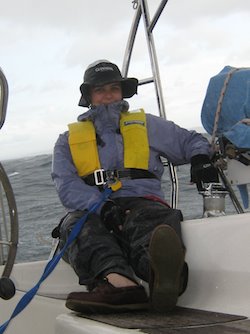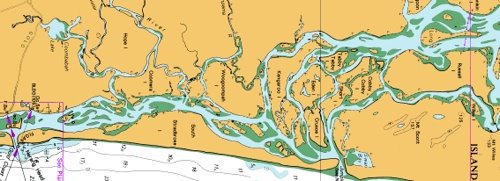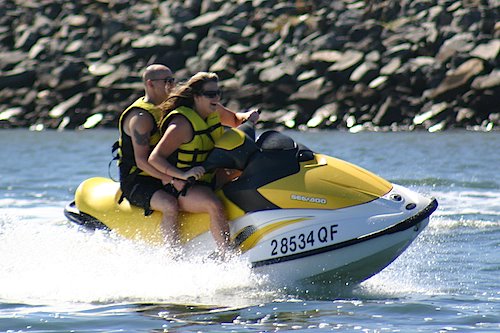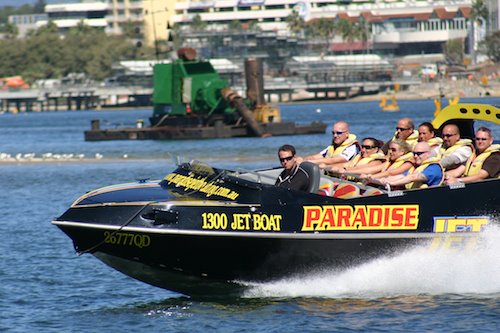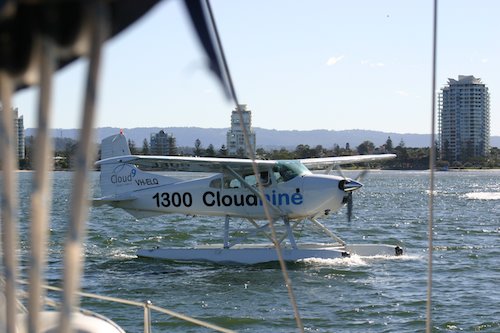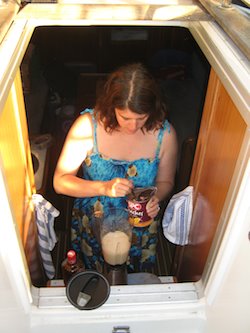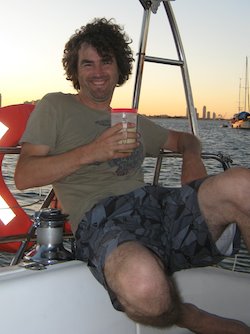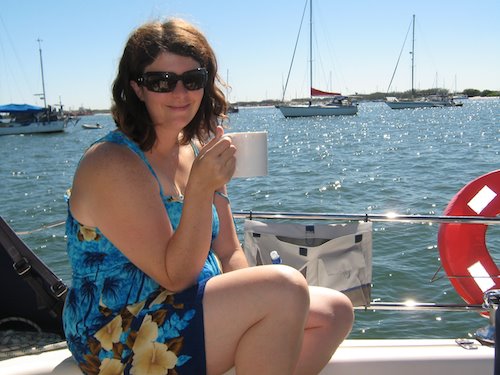We left the Gold Coast on the dawn tide.
I just love that expression. It sounds like something out of an old pirate movie. In actual fact, with the tide turning at dawn, and wanting to wait for at least the third hour of flood before crossing the bar, what it really meant is that we had a leisurely breakfast, prepared the boat for sea, and were lifting anchor at about ten o’clock. But “leaving on the dawn tide” sounds so much more impressive.
We had no problems going out of the Gold Coast Seaway, apart from… “…are those people in the water?”. A quick check with the binoculars revealed that there were indeed a number of surfers swimming across the bar entrance, in amongst the continual trawler, fishing and yacht traffic. Crazy. But a passing police launch manoeuvred politely around one pair who were doggedly paddling down the main channel, so I suppose that this must be normal Surfers Paradise behaviour.
Despite our careful timing of the tide, there was still a bit of an incoming rip, presumably due to some kind of tidal overrun. Bronwyn kept the power on hard coming out of the bar (no smoke! A change of oil and cleaning the air filter seemed to have fixed that one) while I went down into the saloon to check on the location of the nearby shoaling reefs. Once out on the open sea, Bronwyn kept powering directly into incoming the swell, running up each wave and launching off the top to drop into the face of the next one. Down below, I was trying to stay on the chart table seat while juggling a pile of eIectronics and paperwork, and I had some idea of what it must be like to go over the Niagara Falls in a barrel.
I was feeling a bit battered when I emerged blinking into the sunlight, as we rounded the shoals and set off northward, heading for Moreton Bay and Brisbane. It was a beautiful day and we had a perfect light following wind. We experimented for a bit with flying the jib only, just to see what it was like, but quickly switched to the main and found ourselves running at six to eight knots. The only slight difficulty was a quartering swell which made steering quite an energetic task. When the swell approaches the boat on a diagonal, you have to corkscrew up and down each face as it passes under the boat. Still, we were fresh and rested and I enjoyed the exercise for a while before turning control over to the tireless Harriet.
Being used to the NSW forecasts which only try to predict swell heights to within the nearest metre or so and are often wildly inaccurate (eg “Swell: SE 1 to 2 metres” may well turn out to be more than 3), we were quite amused to see that the Queensland forecast was a bit more precise; apparently we could expect to be sailing in exactly 1.7 metres of swell.
VIDEO: STEERING THROUGH QUARTERING SWELL (1.1Mb)
There were very few marine hazards shown on the charts, so we just concentrated on sailing as straight a line as possible. The Eastern Australian Current did have one last go at us around one headland, but after that it seemed to give up. Cashing in on this bonus, we decided to head straight across one large bay instead of hugging the coast, because that would put the swell directly behind us and to tell the truth we were getting a bit tired of the constant pounding. As we got into deeper water, a combination of fair winds and following surf got us up to eight knots, and we had to revise our timetable. We had planned to sail through the night so that we would arrive at Moreton Bay in daylight to negotiate the shoals across the entrance, but it looked like we were going to arrive much earlier, in the middle of the night.
Keeping a lookout, I saw a squall racing towards us and shouted to Bronwyn, who was preparing a meal in the galley. She calmly asked me for a time check for her rice. Exactly seven minutes later we were triple-reefed and back on track, and Bronwyn went back down and took the rice off the stove just as the squall hit us with 35 knots and a flurry of rain. As soon as it had passed, dinner was served.
The rain and the swell kept on harrying us but Pindimara was flying, and by late evening we were approaching the notorious Moreton Bay shoals in pitch darkness and zero visibility. One option would be to stand out to sea and wait for dawn, but we were feeling battered and bruised and just wanted to get out of the swell, so we hove to and got out the charts.
